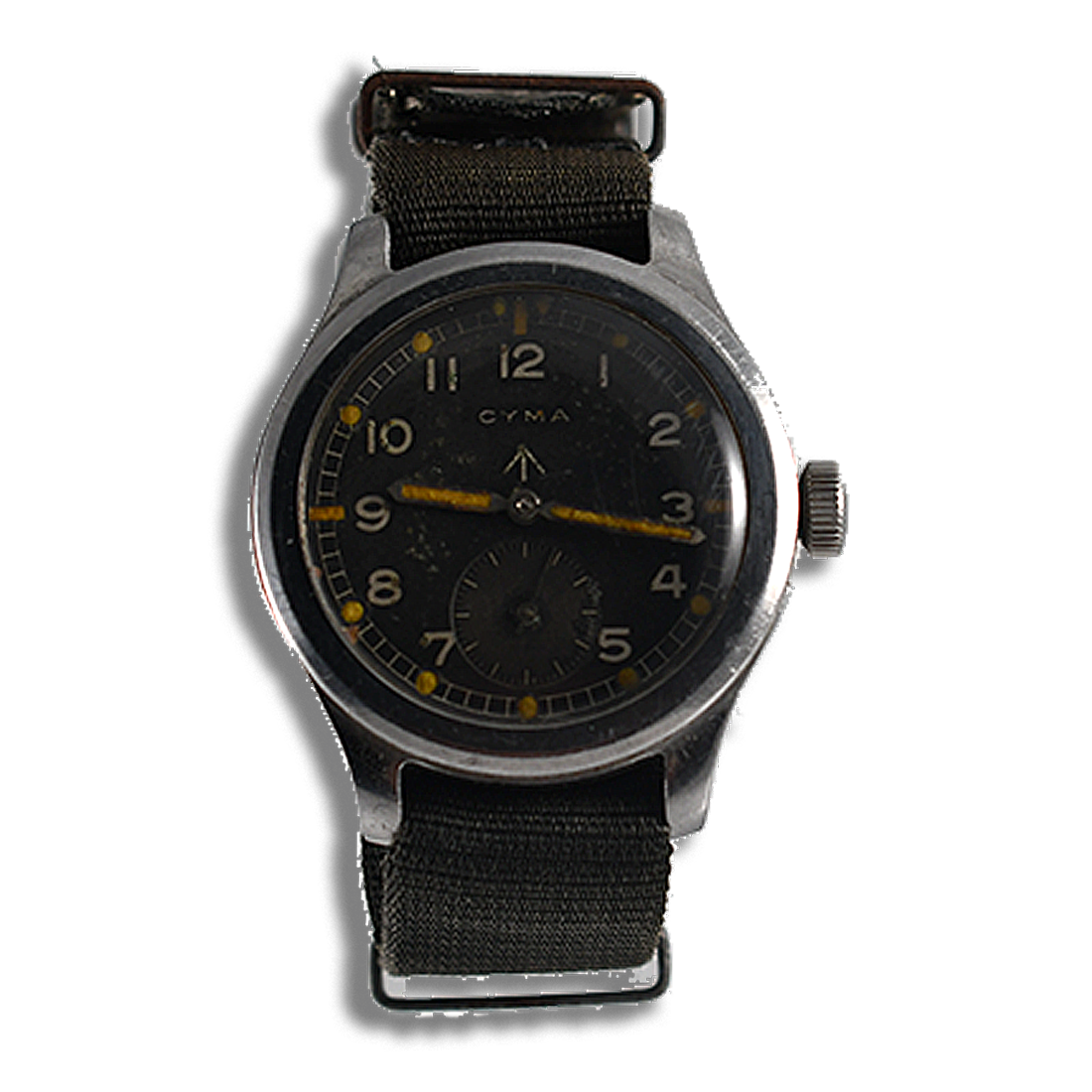Dirty dozen, Churchill's military watches
Appointed Minister of Armaments in July 1917, Winston Churchill became aware long before the dark hours of the Second World War of the importance of standardizing the equipment used by the military during battle. During the First World War, the Allied armies did not have the same armament, making the supply of ammunition and the maintenance of weapons delicate, Churchill will be at the forefront to note that to fill the gaps, many soldiers join the front with their personal equipment, which in the field leads to confusion, approximation and sometimes… disaster.
During a meeting with his colleagues, the purpose of which was to review the events of a particularly deadly battle for the British Expeditionary Force, he became aware of the importance of having the exact time for a soldier and be able to precisely synchronize the watch of the group leaders during an offensive. Indeed, the reason for this high casualty rate was the direct consequence of the impossibility of precisely coordinating the attacks on the front line, the waves of assailants falling one after the other under the enemy bullets, while a coordinated attack would certainly have got the better of the enemy position… this was the first of the elements that led Winston Churchill to design the famous war's wrist watch and the www symbol that would adorn the cases of his famous 25,000 dirty dozen.
Very early before the Second World War, and under the benevolent eye of Winston Churchill, the British Empire will produce by a dozen manufacturers (in order to secure production by multiplying the sources of production) a combat watch to the standard which will have the ambition to allow soldiers of the Commonwealth to have a synchronizable, modern and efficient time measuring instrument, solid and reliable, easy to maintain, easy to use in combat, all at a price compatible with a war economy...
IMAGE
For the specifications of these military watches, the specifications are ambitious for the time, all watches have a dial with a black background, indexed with luminescent numerals, arranged around a circular railroad in twelve hours, and an independent small second’s dial located at six o'clock which will show that the watch is working. The movement is of the hack-watch type (or stop second) to synchronize with a time signal or a reference device. luminous dots hour minute on the timetable railroad. all dirty-dozen watches must be fitted with a hand-wound movement with a minimum of 15 shock-resistant jewels. The movements must respect the size between 11.75 and 13 lines in diameter with performances close to chronometers. the Plexiglas glass must protect the watch and all the dirty dozen must be adequately resistant to splashes of water and dust for the standards of the time. The winding crown must be able to be handled with gloves. They must be engraved with the broad arrow (to mark the property of the British crown) bear the mention W.W.W and the two serial numbers, the first civilian and the second military preceded by the letter corresponding to the manufacturer's code. The bracelet attachments must be fixed and the width between the lugs must be 18 mm wide. The case must be screwed back easy to open and maintain.
IMAGE
These twelve manufactures will be listed with an alphabetical code which corresponds more to a source of supply than a manufacturer as such will be stamped on the bottom of the case before the serial number of the watch, below the broad-arrow and the mention W.W.W followed by the letter which designates the manufacturer and the inventory number of the watch in British stocks. It should be noted that this so-called "matricule" number has the same characteristic as those of most other dirty dozen W.W.W. : by subtracting the registration number (after the letter manufacturer code) from the civil serial number which is generally below, we always obtain the same number. For the Dirty Dozen Cyma, the number you get is 5000, for Longines it is 3724.
The manufacturer code letter A will be assigned only to vertex which will manufacture 15,000 35 mm military watches equipped with the Vertex caliber 59. These watches will be manufactured towards the end of the war between 1944 and 1945 and will be assigned mainly to the British forces of the Commonwealth stationed in the 'Indian Ocean. Those forces that fought Japanese forces on the Pacific front would be generously endowed as the pressure of fighting in the European theater around the start of 1945 eased. After the war, many of these watches will remain in these regions and will be bequeathed to the police or military forces of the protectorates or counters, since many of them will change their status vis-à-vis Great Britain and tend to move towards a partial or total autonomy. (As was the case in India, Singapore or the city of Hong Kong)
IMAGE
For Jaeger Lecoultre, which will manufacture nearly 6,000 dirty-dozen watches based on the caliber JLC-479 movement, this version will benefit from one of the best finishes in the series. The chrome steel case was highly appreciated by the military, particularly for its resistance to dust and tolerance to humidity. On the other hand, the cathedral hands, very much in keeping with the traditional military standards of the time, will help to make it stand out from the crowd, and quite naturally reserve it for the officers of her gracious majesty. For codification and markings, the dirty dozen Jaeger Lecoultre will receive the supply code F (like Longines) and it should be noted that it will be the only dirty dozen that will have to equip itself with a 17 mm strap. width, all the others being 18 mm wide at the lug.
Both manufactured in twenty-five thousand copies, the dirty-dozen omega and record military watches represent the models produced in the greatest number of copies, the omega dirty-dozen model is a steel watch thirty-five millimeters in diameter, with a width between the lugs of 18 mm. The code used to classify this model is the letter Y and its inventory number is the number VB 10033, after the war, this model will be renumbered in NATO codification: 99-445-2031 in the stocks of the British army. The dirty dozen Omega is equipped with an omega 30T2 caliber movement, the hands are in the shape of swords.
IMAGE
For the record model, also very common in combat units in Europe, this model manufactured in the first hours of the Second World War will prove to be particularly appreciated for its high tolerance to shocks and its readability in the dark. Equipped with a reliable caliber 022K movement and baton hands, its 36.5 mm-diameter chrome-plated steel case is extremely shock-resistant and its oversized winder is very easy to handle with any glove or protective gear. The dirty dozen Record bears the letter L, its inventory code is VB 10034 and will be used throughout the war and even then, on this occasion, it will enter post-war NATO stocks with the new inventory code NATO-99-445-9830.
For Longines and its dirty-dozen-watch model produced in 8000 copies, the same manufacturer code as for Jaeger Lecoultre will be used: the letter F, but the inventory code differs, for Longines this code will be VB 100032, This watch often remained on the European theater also features cathedral hands. (Or fly wings) Its movement is a Longines 12.68Z caliber protected by a steel case 38 mm in diameter and equipped with an 18 mm strap often made of leather strap.
The dirty dozen Timor with a caliber 6060, a 36.5 mm steel case and cathedral hands, will be produced in 13,000 copies, it will be found mainly in Africa, Australia and within the armed forces Canadian. It bears the distinctive letter K and its inventory stock number is VB 10036.
IMAGE
Buren will manufacture approximately 11,000 dirty-dozen in the middle of the war, these watches stamped with the H code are listed VB 10026, the movement which animates them is the Buren B-462 caliber, the case is 18 mm wide at the lugs for a case width of 36.5 mm (diameter). Regarding their assignment, they are often found in archival photos of British troops stationed around the Mediterranean, in Malta for example or in Cyprus, Gibraltar and Egypt
For the IWC brand located in Schaffhausen, a Dirty Dozen will be produced before the war in small quantities (5000 copies) this rather rare watch and of good general quality will not be produced in the expected quantities, given the large quantity of watches that 'IWC will produce for the German army and delivery problems due to the geographical location of the production site, (note that the city of Schaffhausen was the only point in Swiss territory to be bombarded by the allies... ) This dirty-dozen IWC is equipped with a caliber 83, a 35 mm case in steel code letter M, a watch which after the war will take the NATO codification 99-445-5890 (inventory codes VB 10028)
IMAGE
Another renowned manufacturer which contributed to the war effort by producing a model from the Dirty-dozen series of military watches was Lemania, famous for the quality of its chronograph movements and the seriousness of its mechanical achievements. Lemania will produce 10,000 Dirty-dozen with a diameter of 36.5 mm with a chrome steel case, a screwed back stamped with the letter Q (inventory reference VB 10031) all equipped with the LW-27A caliber, which is particularly solid and easy to maintain.
The two remaining manufacturers to complete the inventory of the famous Dirty-Dozen military watches are Eterna and Grana, the first, Eterna, a manufacture famous for its civilian chronograph models, will produce at the start of the war around 5000 Dirty-Dozen watches, with a 520 caliber movement, a very good quality steel case with a diameter of 36 mm. the letter preceding the registration number is P (like Cyma) its inventory code is VB-10027, with Grana which will produce less than 5000 Dirty-dozen (35 mm steel case, movement caliber KF320, letter code M and inventory code VB 10029), these two editions remain the rarest and paradoxically are not the most highly rated or sought after, their use during the Second World War being anecdotal or exclusively reserved for England essentially for reasons of maintenance and availability of spare parts .

